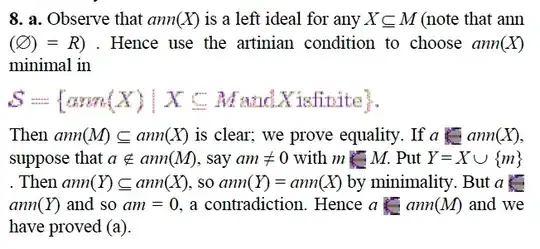The claim of part $(b)$ of the exercise is:
If $R$ is an artinian ring and $M$ is a finitely generated left $R$-module such that $\text{ann}(M)=0$, then $M$ has a submodule isomorphic to $R$.
However the claim, as stated, is false.
Before presenting a counterexample, we state and prove a lemma.
lemma:
If $R$ is an artinian ring, then no proper left ideal of $R$ is isomorphic, as a left $R$-module, to $R$.
Proof of the lemma:
Let $R$ be an artinian ring and suppose $A$ is a left ideal of $R$ which is isomorphic, as a left $R$-module, to $R$.
Our goal is to derive a contradiction.
Let $A_0=A$.
Since $A_0$ is isomorphic, as a left $R$-module, to $R$, it follows that $A_0$ has a proper $R$-submodule, $A_1$ say, which is isomorphic, as a left $R$-module, to $R$.
Note that $A_1$ is also a left ideal of $R$.
Iterating the process, we get a strictly descending infinite chain
$$
A_0\supset A_1\supset A_2\supset\cdots
$$
of left ideals of $R$, contradiction, since $R$ is an artinian ring.
This completes the proof of the lemma.
The counterexample:
Let $R=M_n(K)$ where $K$ is a field and $n\ge 2$.
Regarding $R$ as a vector subspace over $K$, $R$ is finite-dimensional (more precisely, it has dimension $n^2$).
Since every left or right ideal of $R$ is closed under multiplication by elements of $K$, it follows that every left or right ideal of $R$ is vector subspace of $R$.
Since the subspaces of a finite-dimensional vector space satisfy the descending chain condition, it follows that $R$ is an artinian ring.
For $1\le i\le n$, let $a[i]\in R$ be the $n{\times}n$ matrix with all entries in the $i$-th row equal to $1$ and all other entries equal to $0$.
Let $A$ be the left ideal generated by $a[1]$.
Thus, regarding $A$ as an $R$-module, $A$ is finitely generated.
Note that $\det(a[1])=0$.
If $a\in A$, then $a=ra[1]$ for some $r\in R$, hence $\det(a)=\det(r)\det(a[1])=0$.
Thus all elements of $A$ are singular, so the inclusion $A\subset R$ is proper.
Applying the lemma, no $R$-submodule of $A$ is isomorphic to $R$.
It remains to show $\text{ann}(A)=0$.
Let $r\in\text{ann}(A)$.
For $1\le i,j\le n$, let $e[i,j]\in R$ be the $n{\times}n$ matrix with $(i,j)$-th entry equal to $1$ and all other entries equal to $0$.
By definition of $A$, we have $a[1]\in A$.
For $2\le i\le n$, we have $a[i]=e[i,1]a[1]$.
Thus we have $a_1,...,a_n\in A$.
Then from $rA=0$ we get $ra[i]=0$ for all $i\in\{1,...,n\}$.
From $ra[i]=0$ it follows that the $i$-th column of $r$ is zero.
But then all columns of $r$ are zero, so $r=0$.
Thus we have $\text{ann}(A)=0$, so $A$ qualifies as a counterexample to the claim.
